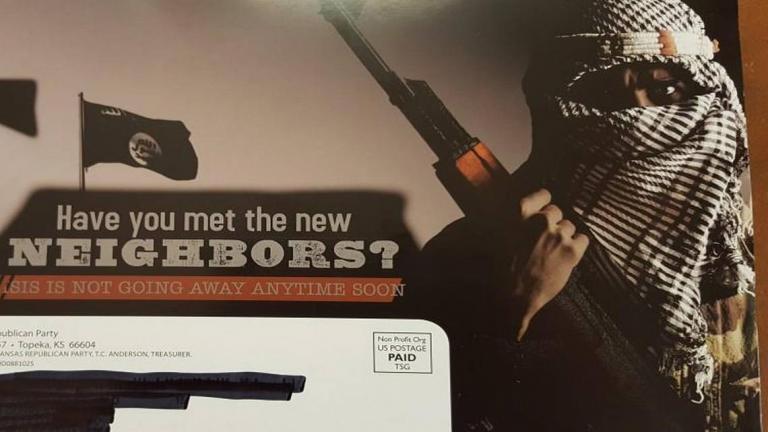In my sermon on Sunday, I talked about the power of fear in our current political climate. And I referenced a particular representative who, in the last election cycle, produced a particularly disgusting and anti-Islam mailer.
On the front, it featured this image of a shadowy, sinister-looking figure in Jihad gear. Note the angry eyes, the font that could be the title screen of a horror movie, and the weapon that, in the hands of a white guy, would be the very emblem of freedom and patriotism. But with this guy holding it, it’s supposed to be scary.
Predictably, the text on the other side outlined how this candidate would protect us from the “Muslim terrorists” that are trying to infiltrate our communities.

That representative was Kevin Yoder, and he won that election. Why dredge this up two years later? Because he’s doing it again; and it’s dangerous.
Just three months after that election, a white man shot two Indian immigrants at a family restaurant in my neighborhood. One of those victims died. The shooter has since been sentenced to life in prison. Good riddance and all that, but here’s what’s worth noting: before firing those shots, witnesses say that he shouted, “Get out of my country!” and “Go back where you came from!” Thing is … he didn’t know where they came from. He just assumed them to be Muslims. Which is why he proudly told a bartender (several counties away, before he was captured) that he had “just shot a couple of Muslims” and needed to lay low for awhile.
Like he’d done the community a favor, and just needed to wait for things to die down before he could just happily go back to his house in the suburbs, two blocks away from mine.
This is Trump’s America, and Kevin Yoder’s Johnson County. Sure, there will always be wackos out there with guns (especially if the NRA maintains its grip on the system); but you can’t tell me there is no correlation between this kind of propaganda and that kind of hate crime. Shamelessly leveraging fear of other to create a tangible villain in your immediate community only perpetuates hatred and misunderstanding. There might not always be a body count, but there will always be consequences.
Like I said, now it is two years later, election day is again upon us, and now he’s doing it again. But this time, the “threat” is not some vague and villainous other—it’s his opponent. And she just happens to be a woman of color.
Sharice Davids is an experienced attorney, an award-winning MMA fighter, a former White House fellow, and the all-around real deal. She stands a (very good) chance of being the first LGBT representative from Kansas, and the first Native American congresswoman from anywhere. (Take a minute to get your heads around that, please: it is 2018 and we’ve never had a Native American woman in congress). This historic campaign is getting nationwide coverage, and Davids has received endorsements from some very high-profile people, including Gloria Steinem herself.
It goes without saying that she opposes Yoder on nearly every issue that matters. But rather than engaging his opponent on those issues, Yoder is doing what many men in his position are doing right now: when faced with a female opponent who has the chops to beat him, he’s not just going negative, he’s trying very hard to make her seem like a threat.
The attack ads feature out-of-context soundbites, so badly edited they’re almost laughable. They show grainy pictures and video of her, unflattering angles and expressions captured to make her look angry, evil or deranged. (Again, a favorite tactic when running a campaign against a female component). The voice over narration is heavy-toned and ominous, matching the scary music score that plays in the background.

While the message varies slightly from his last campaign, the sentiment is the same: here is someone who doesn’t look like “us” (us being the normative straight white majority); here is someone who is “not from here” (ironic, since not only is she from here, SHE IS NATIVE AMERICAN AND SHE WAS HERE BEFORE YOU BRO), someone who is somehow foreign, alien and dark-skinned, being portrayed as the threat to public well-being that should keep you awake at night.

His ads, both print and on screen, use words like “dangerous,” “risky,” and “radical.” The most recent TV commercial features a (blonde, white) mother, speaking fearfully about the potential dangers Davids would post to her children. It’s gross.
It’s also a predictable move from the party that gave up running a campaign on its own merits a long time ago, and must instead use this ugly “othering” tools to make the other person look threatening.
I will grant him this much—Davids is a threat. She’s a threat to him; because progressive voters are coming out full force for her, while more conservative voters—tired of his posturing—would like to see him take a stronger conservative stance on their issues (he tends to waffle. It’s fun to watch).
It is entirely possible that conservatives will stay home this time, and moderates will lean left. So yes, I’d say Sharice Davids is a particular threat to patriarchy; to status quo; to those leaders, like Yoder, who have to create a false adversary in order to make themselves look like a leader.
Maybe we would all do well to take Yoder’s old campaign mailer to heart. Have you met the new neighbors? For that matter, do you know ANY of your neighbors? If you don’t, get on it. Get to know your neighbors to the right and to the left. Get to know the ones who don’t look like you, the ones who aren’t from here. Learn where they work, what they care about, the names of their children. I think if we all truly knew our neighbors, we would be people not so easily manipulated; people not so ready to fear the dark skin, or the head covering; and people with a lot more courage to call B.S. on the kind of racist rhetoric that truly threatens our communities.












